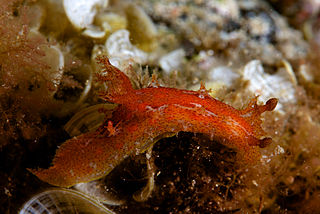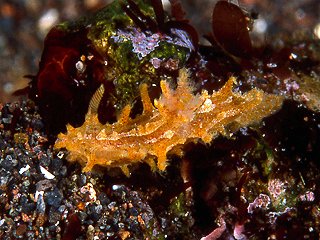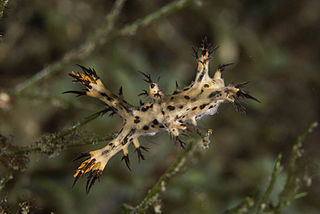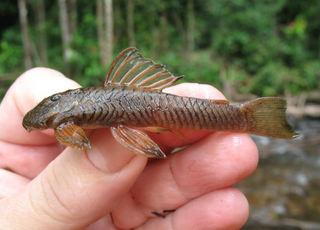
The Indian fritillary is a species of butterfly of the nymphalid or brush-footed family. It is usually found from south and southeast Asia to Australia.

Cherax parvus is a species of crayfish in the family Parastacidae. It is only known from its type locality – the Upper Tully River catchment in the Cardwell Range of north-eastern Queensland – and is listed as data deficient on the IUCN Red List. It was discovered in a rainforest catchment in a highland of northeastern Queensland during a Queensland Museum expedition to the upper Tully River area in November 1992. It is one of the smallest species in the genus. No species of Cherax has been considered endemic to wet upland or highland areas before it was discovered; most previous records were from elevations less than 400 meters. It also has several morphological features unique to the genus, and does not appear closely related to any extant species, suggesting a long period of geographic isolation.

Fiona pinnata, common name Fiona, is a species of small pelagic nudibranch, a marine gastropod mollusk in the superfamily Fionoidea. This nudibranch species lives worldwide on floating objects on seas, and feeds mainly on barnacles, specifically goose barnacles in the genus Lepas.

Nembrotha lineolata is a species of nudibranch, a sea slug, a marine gastropod mollusk in the family Polyceridae. It is found in shallow water in the Indo-Pacific. It was first described in 1905 by the Danish malacologist Rudolph Bergh. The type locality is Selayar Island, Indonesia.

Halgerda carlsoni is a species of sea slug, a dorid nudibranch, shell-less marine gastropod mollusks in the family Discodorididae.

Plocamopherus is a genus of sea slugs, specifically nudibranchs, shell-less marine gastropod molluscs in the family Polyceridae, subfamily Triophinae. A unique character of Plocamopherus species is a globular bioluminescent organ at the tip of the pair of appendages which are placed just behind the gills. Many species are known to be nocturnal and several are from deep water. They feed on bryozoans.
The Philippines angelshark is a species of angelshark, family Squatinidae, known only from a 33 cm (13 in) long immature female caught in the Philippines, where it is the only known representative of its family. It has a flattened body and head with greatly expanded pectoral and pelvic fins, and is greenish above with brown spots. Identifying traits of this species include the spiracles, which are more widely spaced than the eyes and bear papillae on the posterior inner rims, and the relative positions of the two dorsal fins. Additionally, S. caillieti lacks fringes on its barbels, enlarged thorns along the middle of its back, and ocelli ("eyespots") on its fins.
Hellinsia auster is a moth of the family Pterophoridae that is found in the U.S. state of Arizona. The species was first described by William Barnes and Arthur Ward Lindsey in 1921.
Plocamopherus lemur is a species of sea slug, a nudibranch, a shell-less marine gastropod mollusk in the family Polyceridae.
Plocamopherus maculapodium is a species of sea slug, a nudibranch, a shell-less marine gastropod mollusk in the family Polyceridae.

Plocamopherus maderae is a species of sea slug, a nudibranch, a shell-less marine gastropod mollusk in the family Polyceridae.
Plocamopherus margaretae is a species of sea slug, a nudibranch, a shell-less marine gastropod mollusk in the family Polyceridae.
Kaloplocamus dokte is a species of sea slug, a nudibranch, a shell-less marine gastropod mollusk in the family Polyceridae.

Kaloplocamus peludo is a species of sea slug, a nudibranch, a shell-less marine gastropod mollusk in the family Polyceridae.
Kaloplocamus maru is a species of sea slug, a nudibranch, a shell-less marine gastropod mollusk in the family Polyceridae.

Goniodoris citrina is a species of sea slug, a dorid nudibranch, a marine gastropod mollusc in the family Goniodorididae.

Berghia stephanieae is a species of sea slug, an aeolid nudibranch. It is a marine gastropod mollusc in the family Aeolidiidae. It was previously known as Aeolidiella stephanieae.

Cabangus regius is a species of sea slug, a dendronotid nudibranch, a shell-less marine gastropod mollusc in the family Dendronotidae.

Guyanancistrus nassauensis is a species of catfish belonging to the family Loricariidae, the suckermouth armored catfishes. It is discovered in 2005 and formally described in 2018. G. nassauensis is a rare species, highly endemic to the Nassau Mountains in Suriname, and is threatened with extinction by proposed or ongoing mining activities.
Kankelibranchus alhenae is a species of sea slug, a nudibranch, a shell-less marine gastropod mollusc in the family Polyceridae.










